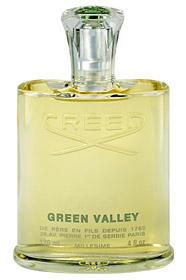Creed’s Green Valley is the feminine answer to Creed’s enigmatic Green Irish Tweed. The softer, gentler, more girly fragrance is supposed to be a similar treatment. I don’t see the similarities, unfortunately. 
In Bottle: Sweet aqueous scent with a fruity note further adding sweetness to the water. This has the sweet water treatment that I smell in similar feminine aqua scents. Including Bath and Body Work’s Dancing Waters. Obviously Green Valley is several steps above Dancing Waters in complexity and beauty.
Applied: More sweet water, slightly green note in the opening. Sweetness come up with the violet leaf as a very pleasant blackcurrant note. Unfortunately, as Green Valley starts to dry down, it falls apart. I seem to be having a spat with lemon notes as the lemon in this fragrance throws everything off as it comes in, tips its hat and proceeds to become the biggest thing in the fragrance, overtaking everything and throwing its weight around to the point where all I smell is unbearably sharp lemon. Once in a while, I can get a safe whiff of what Green Valley was, smooth, sweet, watery and blackcurrant. But the lemon will come in immediately after and exert its massive influence. It’s a shame too as this gigantic lemon will stick around until the dry-down phase where it fades to nothing just before the pleasant woodsy base disappears too.
Extra: I certainly don’t get the Green Irish Tweed tie-in. And it isn’t just me and my feud with the lemon note either. Green Irish Tweed is in a different class than this. If you want to smell like Green Irish Tweed, why not just get Green Irish Tweed? Or the knock-off version, Cool Water.
Design: Bottled in much the same way as other Creed fragrances. This bottle is in a clear glass with a clear cap. Nothing spectacular about it with regards to the design elements though Creeds are fairly well packaged in some lovely and quality material.
Fragrance Family: Fresh
Notes: : Mandarine, bergamot, ginger, lemon, black currant, ambergris, musk.
I’m thinking I should stay away from anything with lemon in it. But just this one particular lemon used in some fragrances that ends up ruining the whole deal. I seem to be fine with the lemon in Pure and Nina. This stupid gigantic lemon, however, has so far ruined Green Valley, Versense, Light Blue, and Covet.
Reviewed in This Post: Green Valley, 2009, Sample Vial.



